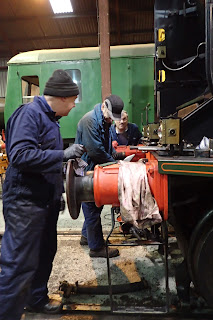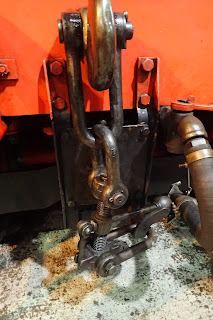The winter maintenance on the operational fleet hasn't precluded a limited amount of work on 3850, work has started on wire brushing and priming sections of the frames. I received this photo from Sam almost a fortnight ago now showing that the drag box had been primed:
 |
| 3850's drag box (Photo courtesy of Sam Perry) |
On Saturday, I noted that the drag box was now in grey undercoat and a section of the frames has received primer:
 |
| Slow but sure progress |
 |
| Tony wire brushing 3850's frames |
 |
| The other side of 3850's frames |
 |
| 7820's piston valve |
 |
| Tony removing rust at the near end... |
 |
| ...then at the far end. |
 |
| Will attaching the valve spindle lubricator |
 |
| Will and Donna refitting the covers on the running plate. |
 |
| Mark measuring tolerances on the fireman's side piston valve. |
 |
| Tom refitting the Peckett's slide valves |
 |
| Bruce refitting the innards of one of the injectors |
 |
| It might get welded and held in reserve as a spare |
 |
| No lubricator here, compare to the photo of Dinmore Manor back up above somewhere. |
 |
| Gil & Bruce, weighing up the pros and cons |
 |
| Something like how it may end up looking |
 |
| Jamie was refitting the washout plugs... |
 |
| ...whilst the buffer beam accoutrements were being refitted |
 |
| Like this! |
 |
| Pony truck... |
 |
| ...frames... |
 |
| ...and wheels, in grey undercoat |
 |
| Chris H, finishing off the grey undercoat... |
 |
| L-R, Ade, Gwendolynne & Chris I putting on brown undercoat... |
 |
| ...the fruits of their labours later on. |
The second point is that several people have come up to me enquiring about were there really 30 Kings made, or 31? For reasons that I shan't bore you with, this is a topic that is of interest to me and a number of years ago I spent a little time researching it. The confusion arises from the Shrivenham Railway Accident of 15th January 1936. The official report, linked to above is an interesting read and explains why having tail lights fitted onto the ends of trains is so important, and why signalmen should check that they are present and correct when trains pass their signal boxes. In short, 6007, King William III at approx 05:30 on the morning of 15th January 1936 crashed into the back of a five wagons and a brake van that had become detached from a preceding goods train hauled by 2802. Apart from being a cautionary tale regarding the duties of signalmen & guards, it is also a reminder that coupling hooks need to be manufactured to a high standard. It's a little hard to track down these days, but "Peto's Register of Great Western Locomotives Volume one" is probably the definitive guide to what happened after the accident as the late Bill Peto was working with the benefit of the having the archives of the GWR available to him. The accident itself was covered on page 36 and on page 37 he goes on to list the substantial number of damaged items to both the locomotive and its tender. He goes on to say that for accounting purposes, the loco was condemned on the 5th of March and a new locomotive was ordered under lot 309 at a cost of £4,393. Conclusive evidence that there were in fact 31 Kings you may think, but not so. The "replacement" loco, also numbered 6007 and named King William III incorporated the frames and even the boiler of the original 6007, in fact there was no need to even remove the boiler from the frames to effect the repairs necessary. She was even returned to traffic on March 24th 1936 paired with the same tender. Laurence Waters' book "The Power of the Kings" covers the accident on pages 14 & 15 in rather less detail than Bill Peto, stating "No 6007 was nominally condemned on 5 March 1936 but was in fact rebuilt using the same boiler, frame and tender, being returned to service at Old Oak Common on 24 March 1936." Kevin McCormack's "Haynes Great Locomotive Series, Great Western Kings" on pages 49 & 50 reports "As a result of the necessary repairs which exceeded that or a normal overhaul, a new lot number was issued and, for accounting purposes, the locomotive was officially condemned on 5 March 1936 (i.e. the company's asset was written off). This seems to have caused some people to conclude that an entirely new locomotive was constructed but, as can be seen from the accompanying photograph, the engine was certainly not destroyed. Many parts were re-used, including major items such as the frames, boiler and tender". The photograph referred to above is the aerial photo which appears on the Shrivenham Heritage Society's website.
It just goes to show that you can't always believe what you read on the web, even on normally reliable sources like Wikipedia. Just in case somebody decides to change it on the strength of reading this, it currently says:
And...


Accounting has a lot to answer for! - in the past many "rebuilds" were in fact new engines and vice versa to suit accounting. A similar error is perpetuated regarding VoR No 9 - which is said to be a rebuild of one of the original Davies and Metcalfe engines, but was in fact a new build (apparently the board had only given approval for two new engines (No's 7&8), so the other was classed as a "heavy repair" of one of the D&M engines which was in fact scrapped!!
ReplyDeleteThe Cotswold preservation link doesn’t seem to work
ReplyDeleteIt looks like they have let the URL lapse. I shall make inquiries.
Delete